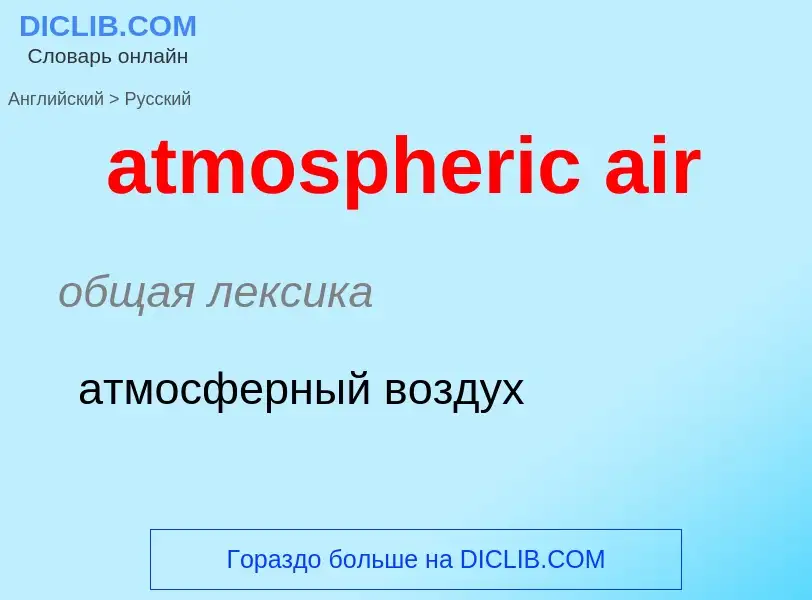Translation and analysis of words by ChatGPT artificial intelligence
On this page you can get a detailed analysis of a word or phrase, produced by the best artificial intelligence technology to date:
- how the word is used
- frequency of use
- it is used more often in oral or written speech
- word translation options
- usage examples (several phrases with translation)
- etymology
atmospheric air - translation to russian
общая лексика
атмосферный воздух
общая лексика
плотность воздуха
Definition
Wikipedia

The atmosphere of Earth is the layer of gases, known collectively as air, retained by Earth's gravity that surrounds the planet and forms its planetary atmosphere. The atmosphere of Earth creates pressure, absorbs most meteoroids and ultraviolet solar radiation, warms the surface through heat retention (greenhouse effect), allowing life and liquid water to exist on the Earth's surface, and reduces temperature extremes between day and night (the diurnal temperature variation).
As of 2023, by mole fraction (i.e., by number of molecules), dry air contains 78.08% nitrogen, 20.95% oxygen, 0.93% argon, 0.04% carbon dioxide, and small amounts of other gases. Air also contains a variable amount of water vapor, on average around 1% at sea level, and 0.4% over the entire atmosphere. Air composition, temperature, and atmospheric pressure vary with altitude. Within the atmosphere, air suitable for use in photosynthesis by terrestrial plants and breathing of terrestrial animals is found only in Earth's troposphere.
Earth's early atmosphere consisted of gases in the solar nebula, primarily hydrogen. The atmosphere changed significantly over time, affected by many factors such as volcanism, life, and weathering. Recently, human activity has also contributed to atmospheric changes, such as global warming, ozone depletion and acid deposition.
The atmosphere has a mass of about 5.15×1018 kg, three quarters of which is within about 11 km (6.8 mi; 36,000 ft) of the surface. The atmosphere becomes thinner with increasing altitude, with no definite boundary between the atmosphere and outer space. The Kármán line, at 100 km (62 mi) or 1.57% of Earth's radius, is often used as the border between the atmosphere and outer space. Atmospheric effects become noticeable during atmospheric reentry of spacecraft at an altitude of around 120 km (75 mi). Several layers can be distinguished in the atmosphere, based on characteristics such as temperature and composition.
The study of Earth's atmosphere and its processes is called atmospheric science (aerology), and includes multiple subfields, such as climatology and atmospheric physics. Early pioneers in the field include Léon Teisserenc de Bort and Richard Assmann. The study of historic atmosphere is called paleoclimatology.



![standard atmosphere]] model (the eight dotted lines in each "decade" are at the eight cubes 8, 27, 64, ..., 729) standard atmosphere]] model (the eight dotted lines in each "decade" are at the eight cubes 8, 27, 64, ..., 729)](https://commons.wikimedia.org/wiki/Special:FilePath/Atmosphere model.png?width=200)

![[[Afterglow]] of the [[troposphere]] (orange), the [[stratosphere]] (blue) and the mesosphere (dark) at which [[atmospheric entry]] begins, leaving smoke trails, such as in this case of a [[spacecraft]] reentry. [[Afterglow]] of the [[troposphere]] (orange), the [[stratosphere]] (blue) and the mesosphere (dark) at which [[atmospheric entry]] begins, leaving smoke trails, such as in this case of a [[spacecraft]] reentry.](https://commons.wikimedia.org/wiki/Special:FilePath/ISS-46 Soyuz TMA-17M reentry.jpg?width=200)
![year=2016 }}</ref><ref>[https://www.nap.edu/openbook/0309100615/gifmid/30.gif Graph: Atmospheric Oxygen and CO2 vs Time]</ref> year=2016 }}</ref><ref>[https://www.nap.edu/openbook/0309100615/gifmid/30.gif Graph: Atmospheric Oxygen and CO2 vs Time]</ref>](https://commons.wikimedia.org/wiki/Special:FilePath/Sauerstoffgehalt-1000mj2.png?width=200)
